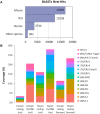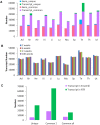A comprehensive rat transcriptome built from large scale RNA-seq-based annotation
- PMID: 32749457
- PMCID: PMC7470976
- DOI: 10.1093/nar/gkaa638
A comprehensive rat transcriptome built from large scale RNA-seq-based annotation
Abstract
The rat is an important model organism in biomedical research for studying human disease mechanisms and treatments, but its annotated transcriptome is far from complete. We constructed a Rat Transcriptome Re-annotation named RTR using RNA-seq data from 320 samples in 11 different organs generated by the SEQC consortium. Totally, there are 52 807 genes and 114 152 transcripts in RTR. Transcribed regions and exons in RTR account for ∼42% and ∼6.5% of the genome, respectively. Of all 73 074 newly annotated transcripts in RTR, 34 213 were annotated as high confident coding transcripts and 24 728 as high confident long noncoding transcripts. Different tissues rather than different stages have a significant influence on the expression patterns of transcripts. We also found that 11 715 genes and 15 852 transcripts were expressed in all 11 tissues and that 849 house-keeping genes expressed different isoforms among tissues. This comprehensive transcriptome is freely available at http://www.unimd.org/rtr/. Our new rat transcriptome provides essential reference for genetics and gene expression studies in rat disease and toxicity models.
© The Author(s) 2020. Published by Oxford University Press on behalf of Nucleic Acids Research.
Figures





References
-
- Davis S., Meltzer P.S.. GEOquery: a bridge between the Gene Expression Omnibus (GEO) and BioConductor. Bioinformatics. 2007; 23:1846–1847. - PubMed
-
- Ji X.J., Feng G.S., Chen G., Shi T.L.. Lack of correlation between aristolochic acid exposure and hepatocellular carcinoma. Sci. China Life Sci. 2018; 61:727–728. - PubMed
-
- Pan Q., Shai O., Lee L.J., Frey B.J., Blencowe B.J.. Deep surveying of alternative splicing complexity in the human transcriptome by high-throughput sequencing. Nat. Genet. 2008; 40:1413–1415. - PubMed
Publication types
MeSH terms
LinkOut - more resources
Full Text Sources

